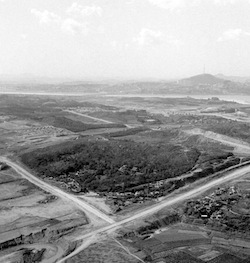1972, Seoul
These apartments, once lauded as the future of housing, are now eyesores. They were initially were seen as a mise-en-scene of a convivial family, replete with comfort, the promise that posterity will achieve equal living conditions. Taken in 1972, this picture represents the monumental construction of the multi-housing complex in the Yong-dong district of southeastern Seoul. The picture is also proof of a developing nation inching towards progress. As such, the apartments also doubled as symbols representing the economic development granted to the “neo-middle class” (a term coined under the Motherland Modernization Proposition). Other such modernization efforts proliferated throughout the country under the motto “Enjoyment at work, contentment in life.” Yet those who desired to rise in this “neo-bourgeois” fashion had to fit into the same cookie-cutter model dream on the road to this “utopian dream.” Today, these same generic matchbox apartments have become the very culprit of social discord as their homogenization has produced negative, alienating results. This has left us with a nagging question: aren’t utopian dreams supposed to come in a variety of shapes and forms?
뉴스레터0
프롤로그: 유토피아/아파트
1972, 서울
지금은 과잉산물이 된 이 미래의 지층들은 공평한 희망, 공평한 안락함, 공평한 자손들이 자라는 행복의 미장센을 선사했다. 1972년 서울 외각 영동지구에 건설 중인 이 주택단지 사진은 개발도상국에게 부여된 과제를 상징적으로 보여주는 증거였다. 당시 ‘조국 근대화’라는 대명제 아래 경제 성장의 견인차 역할을 담당했던 자들에게는 ‘신중산층’이라는 이름과 함께, 건축적 모더니즘의 정수가 깃든 보금자리에 입장할 자격이 부여되었다. “일하는 즐거움, 생활하는 기쁨”의 모토와 함께 유토피아 시대를 알리는 아파트 건설은 한국 전 국토에 급속도로 번졌고 신분 상승을 꿈꾸는 이들은 이 유토피아 호에 승차하기 위해 저마다 가진 꿈과 희망을 네모난 모양으로 정형화했다. 오늘날 국가 지형을 바꿔버린 이 아파트의 대지들은 사회적 불협화음을 내뿜으며 더 이상 공평하지 않은 결과를 이 시대에 낳고 있다. 인간이 꿈꾸는 유토피아에 대한 물음을 남긴 채.

Yong-dong District, Seoul, 1972, National Archives of Korea